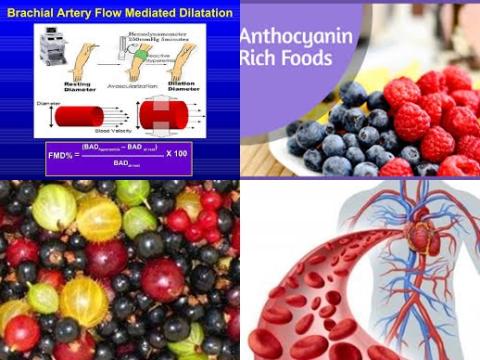
Objectives:
Anthocyanins are of interest due to their anti-oxidative and vasodilatory properties. Earlier reviews have shown that berries and other anthocyanin rich foods or extracts can improve vascular health. However, the effect of anthocyanins on vascular function has not yet been reviewed. Therefore, this review article (meta-analysis) has been conducted.
Does anthocyanin supplementation improve vascular function?
Study design:
This review article included 29 RCTs (15 were parallel and 14 were crossover designs).
Anthocyanin intakes ranged from 1 to 724 mg/day.
Most studies (n = 19) involved participants in the middle to older age group (mean age ≥ 40 years).
The number of participants that completed each study ranged from 10 to 146.
Intervention durations ranged from 1 h to 6 h in the acute studies and one week to six months in the chronic studies.
There was no publication bias.
Results and conclusions:
The investigators found compared to placebo-control, acute anthocyanin supplementation (1-8 h post consumption of anthocyanin doses between 7 and 724 mg) significantly improved FMD [SMD = 3.92%, 95% CI = 1.47 to 6.38, p = 0.002, I2 = 91.8%].
No improvements were observed in PAT-RHI [SMD = 0.08, 95% CI = -0.34 to 0.50, p = 0.71, I2 = 0%].
Collectively, (i.e., the pooling of studies using FMD and/or PAT-RHI) anthocyanins may improve vascular reactivity [overall SMD = 2.41, 95% CI = 0.91 to 3.91, p = 0.002, I2 = 92.6%].
The investigators found compared to placebo-control, acute anthocyanin supplementation (1-8 h post consumption of anthocyanin doses between 7 and 724 mg) also significantly improved arterial stiffness, using PWV [SMD = -1.27 m/s, 95% CI = -1.96 to -0.58, p = 0.000, I2 = 17.9%].
The investigators found pulse wave velocity was improved following acute anthocyanin supplementation only [SMD = -1.27 m/s, 95% CI = -1.96 to -0.58, p = 0.000, I2 = 17.8%].
The investigators found compared to placebo-control, chronic anthocyanin supplementation (one week to six months and used anthocyanin doses of 12 to 320 mg/day) significantly improved FMD [SMD = 0.84%, 95% CI = 0.55 to 1.12, p = 0.000, I2 = 62.5%].
Collectively (i.e., the pooling of studies using FMD and/or PAT-RHI), chronic anthocyanin supplementation may improve vascular reactivity [overall SMD = 0.77, 95% CI = 0.37 to 1.16, p = 0.000, I2 = 85.3%].
The investigators concluded that both acute and chronic anthocyanin supplementation improve vascular health, particularly with respect to vascular reactivity measured by FMD. However, more research is required to determine the optimal dosage and the long-term effects of anthocyanin consumption.
Original title:
The Effect of Anthocyanin-Rich Foods or Extracts on Vascular Function in Adults: A Systematic Review and Meta-Analysis of Randomised Controlled Trials by Fairlie-Jones L, Davison K, […], Hill AM.
Link:
https://www.ncbi.nlm.nih.gov/pmc/articles/PMC5579701/
Additional information of El Mondo:
Find more information/studies on flavonoids and cardiovascular diseases right here.
|
Food items |
Anthocyanin in mg per 100g food |
|
Aubergine (egg plant) |
750 |
|
Black currant |
130-400 |
|
Blackberry |
83-326 |
|
Blueberry |
25-497 |
|
Cherry |
350-400 |
|
Chokeberry |
200-1000 |
|
Cranberry |
60-200 |
|
Elderberry |
450 |
|
Orange |
~200 |
|
Radish |
11-60 |
|
Raspberry |
10-60 |
|
Red currant |
80-420 |
|
Red grape |
30-750 |
|
Red onions |
7-21 |
|
Red wine |
24-35 |
|
Strawberry |
15-35 |